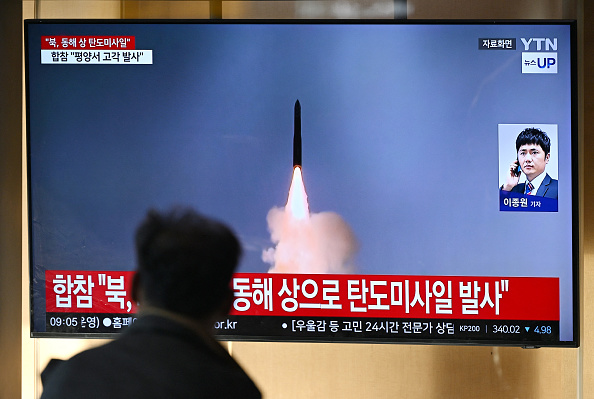North Korea claimed that the intercontinental ballistic missile (ICBM) it tested on Thursday, October 31, was the “most powerful” in the world. However, experts say that this statement is purely for propaganda, as the missile is too large to be effective in a war scenario and could potentially be destroyed by enemies before even being deployed.
On Thursday, North Korea launched an ICBM that flew higher and for a longer duration than any missile previously tested by the country. Foreign experts, however, noted that this test did not demonstrate that North Korea has overcome the final technological hurdles needed to possess an ICBM capable of striking the mainland United States.
North Korean state media, the Korean Central News Agency, referred to the missile as the “Hwasong-19,” calling it the “most powerful strategic missile in the world” and a “perfect weapon system.” The media also reported that leader Kim Jong Un observed the launch, stating that it demonstrated North Korea’s determination to defend national security against external threats.
Experts analyzed launch photos released by North Korean media and determined that the color and shape of the exhaust flames indicated the use of pre-loaded solid fuel, making the missile more flexible and harder to detect compared to those requiring liquid propellant to be added before launch.
However, experts raised doubts about the maneuverability and survivability of both the ICBM and its launch vehicle due to their massive size, as observed in the photos.
Lee Sangmin, an expert from the Korea Defense Research Institute in Seoul, emphasized the decrease in mobility as missile size increases which impacts transport and launch vehicles.
Chang Young-keun, a missile expert at the National Security Strategy Institute in Seoul, estimated the length of the “Hwasong-19” to be at least 28 meters, surpassing the lengths of advanced ICBMs from the United States and Russia, both below 20 meters.
He suggested that the missile’s size could potentially help South Korean intelligence agencies detect launch plans in advance, as the larger profile could make it an easier target for preemptive strikes during a conflict, compromising its survivability.
Lee Il-Woo, an expert from the Korea Defense Network, speculated that North Korea might have developed a larger missile to carry more substantial and destructive warheads or multiple warheads. It is possible the missile uses liquid fuel for higher thrust, with a potential dummy warhead on the “Hwasong-19” to achieve greater flight altitude.
In recent years, North Korea has reported steady progress in acquiring nuclear warhead missiles. Many foreign experts believe the country may have missiles capable of targeting all of South Korea with nuclear strikes but lacks the technology for targeting the U.S. mainland.
Challenges North Korea faces include ensuring warheads can withstand high temperatures and pressures during atmospheric reentry, improving missile height control and guidance systems, and deploying multiple warheads on single missiles to overcome missile defense systems.
Lee Sangmin emphasized that mastering reentry technology, particularly for ICBMs, is crucial for North Korea, but their increasing range may indicate lingering doubts about their confidence in this technology.
Chang Young-keun criticized North Korean media reports on the “Hwasong-19” launch for lacking technical details and focusing more on propaganda.
Other claims regarding North Korea’s weapon capabilities have faced widespread skepticism from the international community. In June, North Korea claimed to have tested a multi-warhead missile, the first known launch of such a weapon, which South Korea later confirmed had exploded.
In July, North Korea declared a test of a new tactical missile capable of carrying “extra-large warheads,” a statement South Korea dismissed as an attempt to cover up a failed launch.
North Korea’s missile program remains a significant regional security threat, with the country openly threatening to use nuclear missiles against its adversaries.
On the day of North Korea’s missile test on October 31, foreign ministers from South Korea, the United States, and Japan issued a joint statement condemning the ICBM launch for violating United Nations Security Council resolutions. They pledged to enhance efforts to prevent North Korea from funding its missile and nuclear programs through illicit means.
South Korea’s Foreign Ministry announced unilateral sanctions on 11 North Korean individuals and four entities suspected of playing roles in procuring missile components and generating foreign currency to finance Pyongyang’s arms programs. These symbolic sanctions, considering financial transactions between South Korea and North Korea have been suspended for years, are largely symbolic.
On Friday, November 1, South Korea and the United States conducted their first joint live-fire exercise using drones to showcase their readiness.
The South Korean Air Force reported that their RQ-4B “Global Hawk” reconnaissance aircraft and the American MQ-9 combat drone were part of the training. South Korea and the United States have been expanding conventional military exercises to address North Korea’s evolving nuclear threats.
Observers noted that Thursday’s launch marked the first ICBM test by North Korea in nearly a year, likely aiming to grab the attention of the United States just days before the presidential election and respond to international criticism of North Korea’s dispatch of troops to support the war in Ukraine.
Reports on North Korea’s troop deployment highlighted the growing military cooperation between North Korea and Russia. Concerns have risen among South Korea, the United States, and other countries that North Korea’s military support to Russia may be in exchange for advanced Russian technologies to advance its nuclear and missile programs.
(This article references reporting from The Associated Press)

